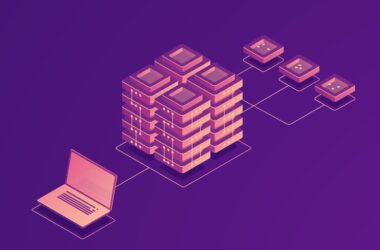Nowadays, digital use is booming. This makes scalable software a must. Sites like Google, Amazon, and Facebook see huge traffic daily. For example, Pornhub.com hit 42 billion visits in 2019. Creating a scalable software architecture is key for modern apps. This ensures they work well as more users come and handling data gets tougher.
Designing software to scale up needs careful planning. This involves building a system that keeps its integrity as demands change. Also, choices made in designing affect costs later on. This is because things like virtual machines and load balancers match the number of requests. It’s crucial to plan for issues such as bottlenecks, especially with databases. They are often the hardest part of a system to scale.
We’re going to look into scalable software architectures more. We’ll cover top methods that let systems support up to 100 million users well. This makes sure they stay efficient and dependable, even when user demand spikes.
Understanding Scalability in Today’s Tech Landscape
Scalability is crucial in meeting the growing software needs in today’s apps. As more users join, systems must handle bigger data and complex tasks well. Scalability ensures software can adapt, making it key for success in our fast-tech world.
The Importance of Scalability for Modern Applications
With millions of apps in stores, tech is more crowded than ever. Disney saw how crucial scalability is when their Applause app couldn’t handle the user surge. This led to bad reviews and hurt the app’s name. It shows scalability is necessary, not just nice to have.
Gartner says scalability lets a system adjust its performance as needed. Developers use agile methods to help software scale smoothly. They focus on both horizontal and vertical scaling to grow with user needs while keeping things running smoothly.
Historical Context: Evolution of Software Scalability
Scalability wasn’t always a big focus until demand spikes made it clear it’s essential. The pandemic showed us the need to be ready for sudden high demand. It hit government and online shops hard. As tech advances, our approach to scalability evolves to meet new challenges.
Now, we use distributed systems for better workload management through horizontal scaling. This spreads out the demand across many nodes. Vertical scaling upgrades a system’s capabilities but might need downtime. Each method has its benefits and fits different needs.
Key Principles of Scalable Software Architecture
Scalability is a must in today’s software world. The main principles behind scalable software architecture are crucial for creating systems that can handle more work. Developers need to focus on building applications that can grow. This involves using modularity, scaling methods, and processing techniques.
Modularity: Creating Independent Software Components
Breaking systems into smaller parts is what modularity is about. This makes developing software easier and improves scalability. By doing this, teams can change a part without affecting the whole system. Modularity lets systems expand more easily. With it, each part can be adjusted as needed, making the system agile and efficient.
Horizontal Scaling vs. Vertical Scaling
It’s important to know the difference between horizontal and vertical scaling. Horizontal scaling means adding more machines to spread the workload. This increases the system’s ability to handle more work. Vertical scaling, on the other hand, means making a single machine more powerful. This can get expensive and there are limits. Horizontal scaling is often the better choice. It lowers the risk of system failure and allows for easy growth.
Utilizing Asynchronous Processing for Efficiency
Asynchronous processing is vital for efficient systems. It lets tasks run separately from direct requests. This helps systems avoid delays when workloads increase. With asynchronous processing, a system can do more things at the same time. This is key for keeping applications fast and responsive, even when they’re under a lot of pressure.
Scalability Strategies for Handling Increased Demands
As demand grows for software that can handle more work, scalability becomes key. Using the right systems greatly affects performance and upkeep. Three main methods are elastic load balancing, using caches, and sharding databases.
Elastic Load Balancing to Manage Traffic
Elastic load balancing is important for managing website traffic. It spreads requests over several servers. This stops any server from getting too busy and slowing down. It makes server response faster, keeping service quality high when there’s more demand.
Caching Mechanisms to Improve Data Access Speed
Caching improves how fast data can be accessed by saving frequently used information in memory. This lessens the burden on databases and makes responses quicker. A good caching setup helps systems stay fast, even with lots of users, and avoids too many database checks.
Sharding Databases for Enhanced Performance
Sharding means breaking a big database into smaller parts for faster query processing. It spreads data over several servers to reduce delay and boost performance. This method makes it easier for systems to handle more users without losing speed or quality.
The Critical Role of Cloud Computing in Achieaching Scalability
Cloud computing is key to scalability in today’s tech world. It lets companies grow without the limits of old systems. The cloud offers many benefits for growth now and in the future.
Benefits of Cloud Infrastructure for Scalable Solutions
Cloud computing makes it easy for companies to add more power quickly. This is very important for businesses like online stores that see a lot of ups and downs in traffic. The cloud has many perks, such as:
- Big savings on the cost of hardware when compared to using local servers.
- Automatic scaling to match what users need right now.
- Less work needed to manage how resources grow, leading to better operations.
- Scaling up in a cost-effective way, with businesses paying only for what they use.
- Better handling of more data and users as a company gets bigger.
Moving to the cloud can make things more efficient but takes careful planning. This is especially true for companies moving from old systems. It’s important to choose cloud providers carefully, looking at how reliable and safe their services are.
Case Studies: Cloud Success Stories
Companies like Netflix show how cloud computing supports growth. They use the cloud to reach a huge audience all over the world. Stories like this show how the cloud helps companies stay flexible and keep services running smoothly, even when lots of users visit at once.
Building Systems with Loose Coupling for Scalability
In modern software development, using a loose coupling approach is key for better scalability. It means each part of the system works on its own, making the whole system more flexible. This is seen in service-oriented architecture and microservices which are great for building scalable systems.
Service-Oriented Architecture (SOA)
Service-oriented architecture splits software into separate services. Each service has its own job and talks to others in a simple way. This setup helps teams to update parts without affecting the rest, boosting performance and system strength.
By doing this, systems become more reliable and easier to keep up. Having clear interfaces helps separate these functions, sticking to the basics of loose coupling.
Microservices: Benefits for Scalability
Microservices take the ideas of service-oriented architecture further. They break applications into even smaller, independent services. Teams can work on, test, and launch these services separately.
This method greatly helps scalability since each service manages its own resources. With microservices, different development activities can happen at the same time, smoothly. This flexibility improves how systems can grow and adapt over time, meeting new business needs.
Identifying and Managing Bottlenecks in Your Architecture
Bottlenecks can greatly slow down a system, impacting how well it works for users. It’s key to spot these issues for a system that can grow and handle more work. Things like shared databases, message queues, and network connections often cause problems. Knowing where these bottlenecks are helps teams fix them.
Common Bottlenecks in Scalable Systems
Some areas that often become bottlenecks include:
- Shared Databases: When database resources are limited, it can make response times longer and slow down everything.
- Message Queues: Delays in queues can make wait times longer and slow down processes.
- Network Connections: If there’s high latency or not enough bandwidth, data transfer slows, affecting speed.
Keeping a system running smoothly depends on how these areas are managed. It’s important to pay attention to these factors to avoid problems as workloads change.
Strategies for Preventing Cascading Failures
As systems grow, so does the risk of cascading failures. A problem in one area can cause issues in others. To avoid this, some architectural patterns include:
- Circuit Breakers: They help the system notice failures and stop requests to services that are failing.
- Bulkheads: They keep services separate so a failure in one doesn’t affect others.
Using these strategies can make a system more resilient and able to handle failures better. This helps keep the system working well, even when there are problems.
Designing Scalable Data Storage Solutions
Today’s businesses gather large amounts of data rapidly, creating a huge need for scalable data storage plans. It’s vital to tackle data challenges, especially as more requests can overload databases. The focus is on making software handle data well and manage more load without losing speed or data quality.
The Challenges of Scaling the Data Tier
Expanding the data part of software brings many challenges. As more users come, databases get hit with more questions, causing slow-downs. A good scalable database approach needs to think about:
- Performance optimization to handle increased traffic.
- Latency reduction to improve user experience.
- Data consistency across distributed systems.
Implementing Data Partitioning Techniques
Data partitioning is a solid strategy for database growth. It splits data horizontally, easing the load on each database. This leads to faster access and better performance when increasing scale. Data partitioning’s main gains include:
- Increased query performance by distributing data across multiple locations.
- Reduced latencies, facilitating quicker response times for users.
- Improved data availability and redundancy through multiple segments.
Observability: Monitoring the Health of Scalable Systems
For scalable software, observability is essential. It uses logging metrics to keep tabs on system health. This way, organizations can spot problems early and improve reliability and user happiness.
Importance of Logging, Metrics, and Tracing
By analyzing logs, metrics, and tracing data, teams can watch their systems closely. This helps them make smart choices. A study in 2023 found that 40% of those asked said better observability made their systems more reliable. They also saw a 100% return on investment, showing the big value of using these tools.
- Increased focus on security, governance, risk, and compliance as primary drivers for observability.
- Integration of business applications within workflows boosts operational efficiency.
- Adoption of AI technologies streamlines processes and fuels innovation.
- Development of cloud-native architectures enhances adaptability and scalability.
- Migration to a multi-cloud environment provides flexibility and resilience.
Tools for Enhancing Observability
Prometheus and Grafana are leading the way in observability tools. They give deep insights into complex systems. These tools help find and fix issues fast, preventing downtime.
Engineers can track important metrics to keep systems running smoothly. Watching these metrics after a release helps teams improve continuously. This ensures systems keep up with changes easily.
Preparing for Future Growth: Evolutionary Architecture
Businesses today must constantly change their software architectures due to new tech and market demands. Keeping up with continuous adaptation helps ensure software systems can meet new challenges efficiently. This is crucial for software to stay responsive and up-to-date.
The Need for Continuous Adaptation
User needs shift often, pushing software to constantly evolve. Technologies like cloud computing, AI, and IoT, influence how software operates. This creates a need for an evolutionary architecture that can quickly adapt while avoiding the slowdowns of outdated systems.
Best Practices for Long-term Scalability Success
For future scalability, businesses should:
- Adopt modular design and microservices to boost scalability and isolate faults.
- Go for incremental refactoring to avoid the pitfalls of big rewrites.
- Use the Strangler Fig Pattern for safer, gradual system updates.
- Embrace cloud-native designs for better performance and simpler operations.
- Implement Continuous Integration and Continuous Delivery to quicken updates and elevate code quality.
Investing in strong monitoring and feedback helps solve problems early and make informed choices. Good documentation makes teamwork and learning easier, reducing mistakes. Automating tests and deployments makes teams more focused and efficient.
Encouraging a culture of experimentation spurs innovation and helps adapt to new tech. For businesses eyeing growth, adopting an evolutionary architecture mindset is key to handling software complexity.
Conclusion
Creating scalable software architecture is key in today’s tech world. As businesses grow, the need to scale up becomes vital, especially in ERP systems. The ideas shared here show how crucial flexibility, reliability, and efficiency are. By following these best practices, companies can avoid the pitfalls of inflexible software that limits growth and performance.
Platforms like Zoom have grown quickly due to unforeseen events, showing how important scalability is. This growth also highlights the role of cloud computing. Microservices offer more flexibility than monolithic structures, allowing for handling more work and faster updates. Knowing the pros and cons of these architectures helps in making smart choices for the future.
By focusing on scalable software, organizations can meet today’s challenges and tomorrow’s opportunities. Those who prioritize scalability will stand out, quickly adapting to new demands and changing markets.






